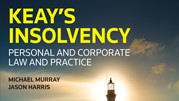As the authors of Keay’s, and in order to assist readers, we propose to make brief reference to law changes or case law decisions that change, or confirm, what appears in the text as at July 2018. Details follow.
A limitation of a law text book is that the law can change at any time soon after the book is published.
The publication of the 10th edition of Keay’s Insolvency in July 2018 was itself delayed in order to include the latest in law reform and case law, including the safe harbour regime and the restriction on ipso facto termination rights. But there were limits – we could not wait for the then proposed debt agreement changes, which were not passed by parliament until September 2018; but given the fact that they were in a bill before parliament, we anticipated and explained them (in chapter 9) and they have since become law.
We think it would be useful to readers, and ourselves, if we maintain a list of law changes and case law decisions that change, or confirm, what appears in the text as at July 2018.
We offer no assurance that this will be complete and timely, but we will endeavour to meet those qualities. If readers themselves are aware of changes, we would be pleased to hear; as well as any comments on the text.
Updates will be recorded in the format of the table below.
They will appear on this website Murrays Legal Commentary, and on Jason Harris’ site Australian Insolvency Law.
Any comments or suggestions as to this approach are welcome.
Michael Murray and Jason Harris
| Keay’s Insolvency 10th ed 2018, Michael Murray and Jason Harris | ||
| Keay – chapter or paragraph | Update | Comment |
| Chapter 9 | Bankruptcy Amendment (Debt Agreement Reform) Act 2018 | Chapter 9 foreshadows this new law, which commences on 27 June 2019 |
| [8.235] | Moss v Gunns Finance Pty Ltd (R&M Apptd) (In liq) [2018] FCAFC 185 | Upholds trial decision – Gunns Finance Pty Ltd (R & M Apptd) (in Liq) v Moss [2017] FCCA 1773 |
| [17.50] | We explain what appears to be obvious, that s 509 CA applies only to voluntary liquidations. This was nevertheless confirmed in Woo International Education Centre Pty Ltd (in liq) (dereg’d) [2019] NSWSC 30. | See www.arita.com.au |
At [10.435] of Keay, we discuss Court inquiries into liquidator misconduct.
Our comments remain but readers are now referred to the decision in Macks v ASIC (No 2) [2019] SASC 17, Doyle J, where ASIC succeeded in obtained an order for investigation of the conduct of a liquidator, going back to 2001, under former s 536 of the Corporations: see now s 90-05 IPSC; s 90-05 IPSB. Arguments were raised about the utility of the inquiry, delay, and whether it was an abuse of process; the threshold for an inquiry is quite low. The law as it was before 2017 applies to these proceedings, given the facts go back to the last decade.
Section 90-10 IPS is the current provision, comparable to former s 536, allowing ASIC and others to apply for an inquiry to be held, with orders made under s 90-15. The same current sections apply in bankruptcy, allowing the Inspector-General to apply, comparable to former s 179 Bankruptcy Act. Broadly, the same pre-2017 case law would apply to the IPS provisions. 24.2.19 MM.



